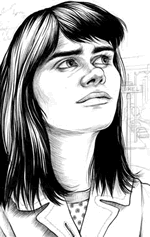Diary of a Teenage Girl
A fascinating new approach to integrating the comic and novel, this Diary uses illustrations and extended comic sequences to give Minnie Goetze, the 15-year-old author, a physical specificity she'd otherwise lack.
That's important, because physical specificity is precisely what Minnie is about. This isn't a coming of age story, because Minnie's age has already arrived: she starts the Diary because she's just made a decision to seduce her Mom's boyfriend and she senses that it's going to be, you know, one of those really, really important decisions.
Minnie is very physical and very specific. She lives in San Francisco, on Clay Street, on the second floor, in 1976, and it's terribly important to her that you know exactly which window is hers.

Gloeckner's career has chiefly been in comics and graphic novels, so that might be a natural. But Minnie's story rests heavily on internal voice and internal dialogue, and that's where prose is best. This innovative blend, somewhere midway between comic and novel, makes a lot of sense.
We get to know Minnie very well. She's fascinating, but she's dim, shallow, irritating, unimaginative, and she skipped school on the day they were handing out empathy. That's not necessarily a flaw; even if you've got a spare ticket, do you want to ask Holden Caulfield to see the Sox beat the Yankees? Perhaps the germ of the character is autobiographical — how could it not be? — and the author, not wanting to boast of her intrinsic wonderfulness, has tried to display for us all her faults in their fullest gloss.
The drawing is brilliant.
